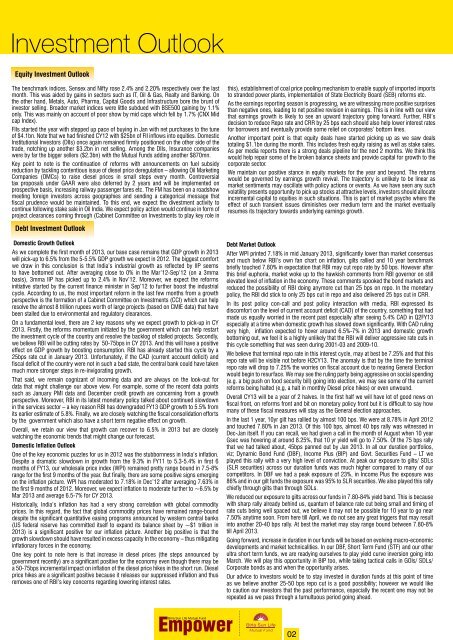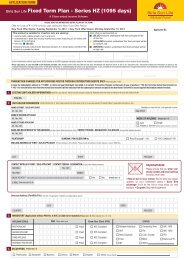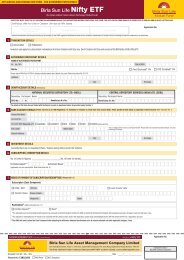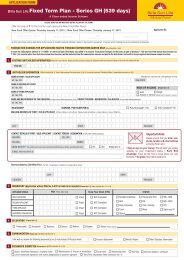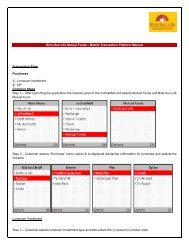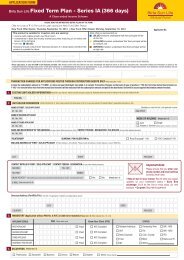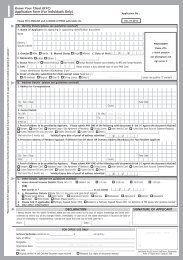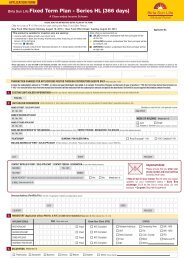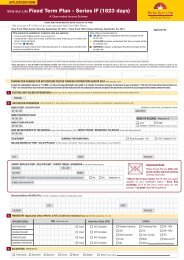Empower for the Month of February 2013 - Birla Sun Life Mutual Fund
Empower for the Month of February 2013 - Birla Sun Life Mutual Fund
Empower for the Month of February 2013 - Birla Sun Life Mutual Fund
Create successful ePaper yourself
Turn your PDF publications into a flip-book with our unique Google optimized e-Paper software.
Investment Outlook<br />
Equity Investment Outlook<br />
The benchmark indices, Sensex and Nifty rose 2.4% and 2.20% respectively over <strong>the</strong> last<br />
month. This was aided by gains in sectors such as IT, Oil & Gas, Realty and Banking. On<br />
<strong>the</strong> o<strong>the</strong>r hand, Metals, Auto, Pharma, Capital Goods and Infrastructure bore <strong>the</strong> brunt <strong>of</strong><br />
investor selling. Broader market indices were little subdued with BSE500 gaining by 1.1%<br />
only. This was mainly on account <strong>of</strong> poor show by mid caps which fell by 1.7% (CNX Mid<br />
cap Index).<br />
FIIs started <strong>the</strong> year with stepped up pace <strong>of</strong> buying in Jan with net purchases to <strong>the</strong> tune<br />
<strong>of</strong> $4.1bn. Note that we had finished CY12 with $25bn <strong>of</strong> FII inflows into equities. Domestic<br />
Institutional Investors (DIIs) once again remained firmly positioned on <strong>the</strong> o<strong>the</strong>r side <strong>of</strong> <strong>the</strong><br />
trade, notching up ano<strong>the</strong>r $3.2bn in net selling. Among <strong>the</strong> DIIs, Insurance companies<br />
were by far <strong>the</strong> bigger sellers ($2.3bn) with <strong>the</strong> <strong>Mutual</strong> <strong>Fund</strong>s adding ano<strong>the</strong>r $870mn.<br />
Key point to note is <strong>the</strong> continuation <strong>of</strong> re<strong>for</strong>ms with announcements on fuel subsidy<br />
reduction by tackling contentious issue <strong>of</strong> diesel price deregulation – allowing Oil Marketing<br />
Companies (OMCs) to raise diesel prices in small steps every month. Controversial<br />
tax proposals under GAAR were also deferred by 2 years and will be implemented on<br />
prospective basis, increasing railway passenger fares etc. The FM has been on a roadshow<br />
meeting <strong>for</strong>eign investors across geographies and sending a categorical message that<br />
fiscal prudence would be maintained. To this end, we expect <strong>the</strong> divestment activity to<br />
continue following stake sale in Oil India. We expect policy action would continue in <strong>for</strong>m <strong>of</strong><br />
project clearances coming through (Cabinet Committee on Investments to play key role in<br />
this), establishment <strong>of</strong> coal price pooling mechanism to enable supply <strong>of</strong> imported imports<br />
to stranded power plants, implementation <strong>of</strong> State Electricity Board (SEB) re<strong>for</strong>ms etc.<br />
As <strong>the</strong> earnings reporting season is progressing, we are witnessing more positive surprises<br />
than negative ones, leading to net positive revision in earnings. This is in line with our view<br />
that earnings growth is likely to see an upward trajectory going <strong>for</strong>ward. Fur<strong>the</strong>r, RBI’s<br />
decision to reduce Repo rate and CRR by 25 bps each should also help lower interest rates<br />
<strong>for</strong> borrowers and eventually provide some relief on corporates’ bottom lines.<br />
Ano<strong>the</strong>r important point is that equity deals have started picking up as we saw deals<br />
totaling $1.1bn during <strong>the</strong> month. This includes fresh equity raising as well as stake sales.<br />
As per media reports <strong>the</strong>re is a strong deals pipeline <strong>for</strong> <strong>the</strong> next 2 months. We think this<br />
would help repair some <strong>of</strong> <strong>the</strong> broken balance sheets and provide capital <strong>for</strong> growth to <strong>the</strong><br />
corporate sector.<br />
We maintain our positive stance in equity markets <strong>for</strong> <strong>the</strong> year and beyond. The returns<br />
would be governed by earnings growth revival. The trajectory is unlikely to be linear as<br />
market sentiments may oscillate with policy actions or events. As we have seen any such<br />
volatility presents opportunity to pick up stocks at attractive levels, investors should allocate<br />
incremental capital to equities in such situations. This is part <strong>of</strong> market psyche where <strong>the</strong><br />
effect <strong>of</strong> such transient issues diminishes over medium term and <strong>the</strong> market eventually<br />
resumes its trajectory towards underlying earnings growth.<br />
Debt Investment Outlook<br />
Domestic Growth Outlook<br />
As we complete <strong>the</strong> first month <strong>of</strong> <strong>2013</strong>, our base case remains that GDP growth in <strong>2013</strong><br />
will pick-up to 6.5% from <strong>the</strong> 5-5.5% GDP growth we expect in 2012. The biggest com<strong>for</strong>t<br />
we draw in this conclusion is that India’s industrial growth as reflected by IIP seems<br />
to have bottomed out. After averaging close to 0% in <strong>the</strong> Mar’12-Sep’12 (on a 3mma<br />
basis), 3mma IIP has picked up to 2.4% in Nov’12. Moreover, we expect <strong>the</strong> re<strong>for</strong>ms<br />
initiative started by <strong>the</strong> current finance minister in Sep’12 to fur<strong>the</strong>r boost <strong>the</strong> industrial<br />
cycle. According to us, <strong>the</strong> most important re<strong>for</strong>m in <strong>the</strong> last few months from a growth<br />
perspective is <strong>the</strong> <strong>for</strong>mation <strong>of</strong> a Cabinet Committee on Investments (CCI) which can help<br />
resolve <strong>the</strong> almost 8 trillion rupees worth <strong>of</strong> large projects (based on CMIE data) that have<br />
been stalled due to environmental and regulatory clearances.<br />
On a fundamental level, <strong>the</strong>re are 2 key reasons why we expect growth to pick-up in CY<br />
<strong>2013</strong>. Firstly, <strong>the</strong> re<strong>for</strong>ms momentum initiated by <strong>the</strong> government which can help restart<br />
<strong>the</strong> investment cycle <strong>of</strong> <strong>the</strong> country and resolve <strong>the</strong> backlog <strong>of</strong> stalled projects. Secondly,<br />
we believe RBI will be cutting rates by 50-75bps in CY <strong>2013</strong>. And this will have a positive<br />
effect on GDP growth by boosting consumption. RBI has already started this cycle by a<br />
25bps rate cut in January <strong>2013</strong>. Un<strong>for</strong>tunately, if <strong>the</strong> CAD (current account deficit) and<br />
fiscal deficit <strong>of</strong> <strong>the</strong> country were not in such a bad state, <strong>the</strong> central bank could have taken<br />
much more stronger steps in re-invigorating growth.<br />
That said, we remain cognizant <strong>of</strong> incoming data and are always on <strong>the</strong> look-out <strong>for</strong><br />
data that might challenge our above view. For example, some <strong>of</strong> <strong>the</strong> recent data points<br />
such as January PMI data and December credit growth are concerning from a growth<br />
perspective. Moreover, RBI in its latest monetary policy talked about continued slowdown<br />
in <strong>the</strong> services sector – a key reason RBI has downgraded FY13 GDP growth to 5.5% from<br />
its earlier estimate <strong>of</strong> 5.8%. Finally, we are closely watching <strong>the</strong> fiscal consolidation ef<strong>for</strong>ts<br />
by <strong>the</strong> government which also have a short term negative effect on growth.<br />
Overall, we retain our view that growth can recover to 6.5% in <strong>2013</strong> but are closely<br />
watching <strong>the</strong> economic trends that might change our <strong>for</strong>ecast.<br />
Domestic Inflation Outlook<br />
One <strong>of</strong> <strong>the</strong> key economic puzzles <strong>for</strong> us in 2012 was <strong>the</strong> stubbornness in India’s inflation.<br />
Despite a dramatic slowdown in growth from <strong>the</strong> 9.3% in FY11 to 5.3-5.4% in first 6<br />
months <strong>of</strong> FY13, our wholesale price index (WPI) remained pretty range bound in 7.5-8%<br />
range <strong>for</strong> <strong>the</strong> first 9 months <strong>of</strong> <strong>the</strong> year. But finally, <strong>the</strong>re are some positive signs emerging<br />
on <strong>the</strong> inflation picture. WPI has moderated to 7.18% in Dec’12 after averaging 7.63% in<br />
<strong>the</strong> first 9 months <strong>of</strong> 2012. Moreover, we expect inflation to moderate fur<strong>the</strong>r to ~6.5% by<br />
Mar <strong>2013</strong> and average 6.5-7% <strong>for</strong> CY <strong>2013</strong>.<br />
Historically, India’s inflation has had a very strong correlation with global commodity<br />
prices. In this regard, <strong>the</strong> fact that global commodity prices have remained range-bound<br />
despite <strong>the</strong> significant quantitative easing programs announced by western central banks<br />
(US federal reserve has committed itself to expand its balance sheet by ~$1 trillion in<br />
<strong>2013</strong>) is a significant positive <strong>for</strong> our inflation picture. Ano<strong>the</strong>r big positive is that <strong>the</strong><br />
growth slowdown should have resulted in excess capacity In <strong>the</strong> economy – thus mitigating<br />
inflationary <strong>for</strong>ces in <strong>the</strong> economy.<br />
One key point to note here is that increase in diesel prices (<strong>the</strong> steps announced by<br />
government recently) are a significant positive <strong>for</strong> <strong>the</strong> economy even though <strong>the</strong>re may be<br />
a 50-75bps incremental impact on inflation <strong>of</strong> <strong>the</strong> diesel price hikes in <strong>the</strong> short run. Diesel<br />
price hikes are a significant positive because it releases our suppressed inflation and thus<br />
removes one <strong>of</strong> RBI’s key concerns regarding lowering interest rates.<br />
Debt Market Outlook<br />
After WPI printed 7.18% in mid January <strong>2013</strong>, significantly lower than market consensus<br />
and much below RBI’s own fan chart on inflation, gilts rallied and 10 year benchmark<br />
briefly touched 7.80% in expectation that RBI may cut repo rate by 50 bps. However after<br />
this brief euphoria, market woke up to <strong>the</strong> hawkish comments from RBI governor on still<br />
elevated level <strong>of</strong> inflation in <strong>the</strong> economy. These comments spooked <strong>the</strong> bond markets and<br />
reduced <strong>the</strong> possibility <strong>of</strong> RBI doing anymore cut than 25 bps on repo. In <strong>the</strong> monetary<br />
policy, <strong>the</strong> RBI did stick to only 25 bps cut in repo and also delivered 25 bps cut in CRR.<br />
In its post policy con-call and post policy interaction with media, RBI expressed its<br />
discom<strong>for</strong>t on <strong>the</strong> level <strong>of</strong> current account deficit (CAD) <strong>of</strong> <strong>the</strong> country, something that had<br />
made us equally worried in <strong>the</strong> recent past especially after seeing 5.4% CAD in Q2FY13<br />
especially at a time when domestic growth has slowed down significantly. With CAD ruling<br />
very high, inflation expected to hover around 6.5%-7% in <strong>2013</strong> and domestic growth<br />
bottoming out, we feel it is a highly unlikely that <strong>the</strong> RBI will deliver aggressive rate cuts in<br />
this cycle something that was seen during 2001-03 and 2009-10.<br />
We believe that terminal repo rate in this interest cycle, may at best be 7.25% and that this<br />
repo rate will be visible not be<strong>for</strong>e H2CY13. The anomaly is that by <strong>the</strong> time <strong>the</strong> terminal<br />
repo rate will drop to 7.25% <strong>the</strong> worries on fiscal account due to nearing General Election<br />
would begin to resurface. We may see <strong>the</strong> ruling party being aggressive on social spending<br />
(e.g. a big push on food security bill) going into election, we may see some <strong>of</strong> <strong>the</strong> current<br />
re<strong>for</strong>ms being halted (e,g, a halt in monthly Diesel price hikes) or even unwound.<br />
Overall CY13 will be a year <strong>of</strong> 2 halves. In <strong>the</strong> first half we will have lot <strong>of</strong> good news on<br />
fiscal front, on re<strong>for</strong>ms front and bit on monetary policy front but it is difficult to say how<br />
many <strong>of</strong> <strong>the</strong>se fiscal measures will stay as <strong>the</strong> General election approaches.<br />
In <strong>the</strong> last 1 year, 10yr gilt has rallied by almost 100 bps. We were at 8.78% in April 2012<br />
and touched 7.80% in Jan <strong>2013</strong>. Of this 100 bps, almost 40 bps rally was witnessed in<br />
Dec-Jan itself. If you can recall, we had given a call in <strong>the</strong> month <strong>of</strong> August when 10 year<br />
Gsec was hovering at around 8.25%, that 10 yr yield will go to 7.50%. Of <strong>the</strong> 75 bps rally<br />
that we had talked about, 45bps panned out by Jan <strong>2013</strong>. In all our duration portfolios,<br />
viz; Dynamic Bond <strong>Fund</strong> (DBF), Income Plus (BIP) and Govt. Securities <strong>Fund</strong> – LT we<br />
played this rally with a very high level <strong>of</strong> conviction. At peak our exposure to gilts/ SDLs<br />
(SLR securities) across our duration funds was much higher compared to many <strong>of</strong> our<br />
competitors. In DBF we had a peak exposure <strong>of</strong> 23%, in Income Plus <strong>the</strong> exposure was<br />
86% and in our gilt funds <strong>the</strong> exposure was 95% to SLR securities. We also played this rally<br />
chiefly through gilts than through SDLs.<br />
We reduced our exposure to gilts across our funds in 7.80-84% yield band. This is because<br />
with sharp rally already behind us, quantum <strong>of</strong> balance rate cut being small and timing <strong>of</strong><br />
rate cuts being well spaced out, we believe it may not be possible <strong>for</strong> 10 year to go near<br />
7.50% anytime soon. From here till April, we do not see any great triggers that may result<br />
into ano<strong>the</strong>r 20-40 bps rally. At best <strong>the</strong> market may stay range bound between 7.80-8%<br />
till April <strong>2013</strong>.<br />
Going <strong>for</strong>ward, increase in duration in our funds will be based on evolving macro-economic<br />
developments and market technicalities. In our DBF, Short Term <strong>Fund</strong> (STF) and our o<strong>the</strong>r<br />
ultra short term funds, we are readying ourselves to play yield curve inversion going into<br />
March. We will play this opportunity in BIP too, while taking tactical calls in GOIs/ SDLs/<br />
Corporate bonds as and when <strong>the</strong> opportunity arises.<br />
Our advice to investors would be to stay invested in duration funds at this point <strong>of</strong> time<br />
as we believe ano<strong>the</strong>r 25-50 bps repo cut is a good possibility; however we would like<br />
to caution our investors that <strong>the</strong> past per<strong>for</strong>mance, especially <strong>the</strong> recent one may not be<br />
repeated as we pass through a tumultuous period going ahead.<br />
02


